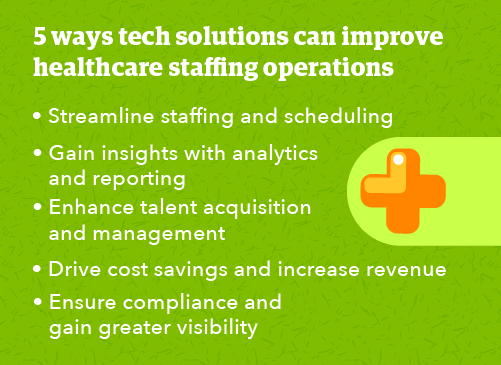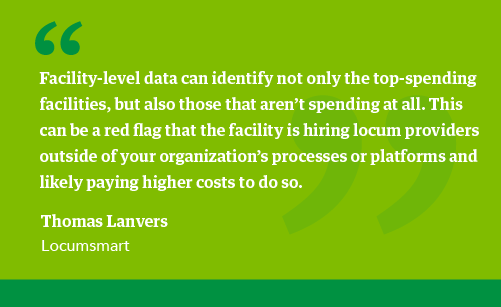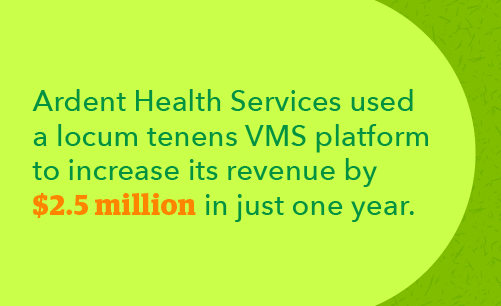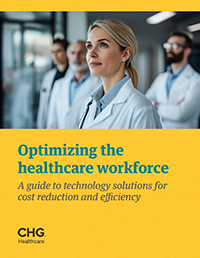
The healthcare industry is facing many challenges, from staffing shortages and rising labor costs to increasing patient demands. To navigate these complexities and maintain high-quality care, healthcare executives need to embrace innovative solutions. Implementing healthcare staffing technology can be a game-changer, offering a range of benefits that drive efficiency, reduce costs, and ultimately improve patient outcomes.
Here are five ways implementing technology solutions can improve healthcare staffing operations.

1. Streamline operations for staffing and scheduling
One of the most significant advantages of healthcare staffing technology is the ability to optimize workforce management. AI-powered staffing and scheduling platforms can automate shift assignments, reduce administrative burdens, and ensure adequate staffing levels.
These platforms can anticipate staffing needs based on historical trends and patient volume, enabling proactive decision-making and reducing the risk of understaffing or overstaffing.
For facilities that use locum tenens physicians, staffing platforms can help you determine what your needs are, how much they’ll cost, and if you should make changes to your long-term recruitment efforts. “If you're a recruiter, you can dive into rates and try to anticipate how much a locum need would cost for one of your facilities, how many bids you're going to receive on that, how long it'll take to fill,” says Garrett Wolfe, business intelligence manager at Locumsmart.
2. Gain insights with real-time workforce analytics and reporting
Another key benefit of healthcare staffing technology is the ability to access real-time workforce analytics and reporting. These tools provide deeper visibility into key metrics such as labor costs, staffing ratios, overtime trends, and employee turnover.
By consolidating data from various sources, healthcare leaders can make data-driven decisions to optimize resource allocation, reduce unnecessary expenses, and improve retention strategies.
It can also help you identify areas where problems are occurring. Thomas Lanvers, SVP of business development and customer success at Locumsmart, says that facility-level data can identify not only the top-spending facilities, but also those that aren’t spending at all. This can be a red flag that the facility is hiring locum providers outside of your organization’s processes or platforms and likely paying higher costs to do so. “It's 100% about being able to see and then act,” Lanvers says.

3. Enhance talent acquisition and management
Efficient talent acquisition and staff management are critical for building a resilient healthcare workforce. Modern applicant tracking systems (ATS) and onboarding tools streamline recruitment by simplifying candidate sourcing, interview scheduling, and credential verification.
AI-powered matchmaking takes this further by aligning candidates with positions based on skills, experience, and workforce needs, resulting in a better fit and higher retention rates.
Technology solutions can also help you pinpoint problems in your recruitment efforts. “If you have changes in your fill rate, you want to look at why. Your actions and behaviors can influence that number,” Lanvers says, pointing to the average time it takes to review a CV as one factor that can influence fill rate. “Applicants may go somewhere else if you don’t respond quickly.”
Enhance the physician recruiting process: A guide to using AI
4. Drive cost savings and increase revenue
Implementing healthcare staffing technology offers numerous benefits that directly impact the bottom line and patient care quality. These solutions can significantly reduce labor costs by optimizing staffing levels and reducing reliance on temporary labor, such as locum tenens. Automated scheduling and timekeeping can help minimize administrative burdens and allow staff to focus on more important matters.

For example, Ardent Health Services used a locum tenens VMS platform to increase its revenue by $2.5 million in just one year. By increasing workflow efficiency around requesting assignments, paying vendors, and enrolling physicians with insurers, the organization saved staff time, increased its quality assurance process, and ultimately saved money.
5. Ensure compliance and gain greater visibility
Healthcare staffing technology helps maintain regulatory compliance by automating timekeeping, credential management, and adherence to labor regulations. It can also reduce the administrative burden associated with tracking employee certifications and training.
For example, Modio Health, a cloud-based credentialing platform, tracks providers’ certifications and documents and notifies staff when renewals are needed to stay in compliance. By partnering with Modio, Logan Physicians Practice, a subsidiary of Scion Health, boosted its revenue by $400,000 by streamlining its credentialing and payer enrollment processes.
Additionally, these solutions provide real-time visibility into key workforce metrics, enabling data-driven decision-making and identifying areas for improvement. Enhanced visibility into the contingent workforce, such as locum staff, provides a more accurate picture of staffing needs and costs.
Get the latest: Trends in telehealth in 2025
Successful deployment brings long-term success
To ensure a smooth transition and maximum benefits, careful planning is essential when selecting and deploying a new healthcare staffing technology. Key considerations include integration with existing systems, data security and privacy, effective change management, user adoption, and ROI analysis.
Collaborating with a vendor committed to ongoing support and innovation is crucial for long-term success. As healthcare organizations grow and evolve, technology must be scalable and adaptable to future demands. By aligning with a vendor that offers robust training, accessible support, and a clear roadmap for future upgrades, healthcare executives can ensure the technology remains relevant and effective as their needs change.
Want more information about implementing technology solutions into your healthcare staffing planning? Download the white paper by clicking the image below.

Contact CHG Healthcare today to learn how our innovative solutions can help you streamline operations, reduce costs, and drive better patient outcomes. Give us a call at 866.588.5996 or email ecs.contact@chghealthcare.com.
This article was created with the assistance of AI technology.